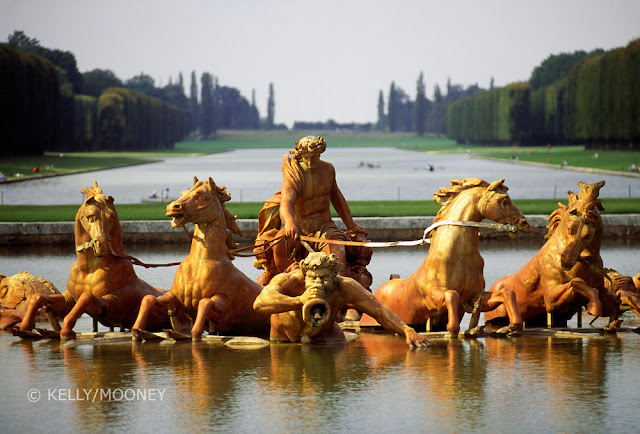 |
| Versailles Palace |
 |
| Hall of Mirrors |
 |
| Royal Chambers |
 |
| Grand Canal |
It was quite sunny and the weather quite pleasant as we entered the royal Versailles Gardens. As the time given for us was just two hours, we could not see the entire garden complex spreading over a vast area of 1976 acres, an impossible task indeed. Besides this garden is an artistic fusion of marble sculptures, fountains, grottoes, lawns, canals and French horticulture. The garden was developed in graceful patterns, curves and concentric circles. To the the onlooker the whole gardens seem like chiseled architecture spread on the ground enriched with colors and embossed with marble statues and fountains. Every vase and pedestal is a piece of art and no object appears plain and simple. So it is a paradise of epic description which my prosaic pen may not express in a vivid manner. Hence I shall try to give a partial and brief description of some parts of the gardens I have seen.
We just passed by the palace as the royal gardens are located to the west of the palace. Previously at this palace Louis XIII had built a hunting lodge in 1631. The whole area was a dense jungle with a hamlet far away from the city. Louis XIV during his long rule developed this p As soon as we entered the garden we saw Versailles Palace, a splendid and spacious mansion sprawled over a vast area, glittering in white with gilded windows. The palace, the royal residence of French kings from Louis XIV to Louis XVI has 350 rooms and Louis XIV used to hold meetings and parties here attended by 3000 guests. Louis XIV metaphorically viewed himself as the Sun, symbol of power, light and lordship. So he tried to re-create the dazzling world of Apollo, the Greek Sun God, in the palace as well as in the surrounding gardens to show off his opulence, grandeur and immense power. After the Revolution Napoleon did not prefer to stay in this palace. In later times Charles De Gaulle converted the northern wing of the palace into an official Presidential residence. The Treaty of Versailles ending the World War I was signed here in the Grand Gallerie (Hall of Mirrors) in June 1919. Some portions of this magnificent palace were converted into a museum depicting the History of France.
We just passed by the palace as the royal gardens are located to the west of the palace. Previously at this place Louis XIII had built a hunting lodge in 1631. The whole area was a dense jungle with a small hamlet located far away from the city. Louis XIV during his long rule developed this place by building this palace and laying out this spacious garden on a grand scale. It took almost 40 years to set up this idyllic paradise with the help of the architect, Louis Le Vau, the painter, Charles Le Brun and the landscape artist, Andre Le Notre. The king expanded and beautified the palace between 1661 and 1668.Jean Baptist Colbert, superintendent of the king's buildings looked after this project from 1664 to 1683. In this garden an astounding variety of trees like elms,lindens,chestnut trees, beech trees, and acacia along with flower plants like lillies, roses, jonquils and tulips are seen. Many trees and plants were imported from Turkey, Netherlands and other countries. The orangery was set up by Jules Hardouin Mansart between 1684 and 1686 replacing the smaller one built by Le Vau in 1663. This orangery is spread over three hectares having more than one thousand plants of various types like palm trees, oleanders, orange trees and pomegranate trees.
 |
| Orangery at Versailles |
 |
| Apollo Fountain |
 |
| Latona Fountain |
 |
| Dragon Fountain |
 |
| Neptune Pool |
 |
| Flora Fountain (Spring) |
 |
| Ceres Fountain (Summer) |
 |
| Bacchus Fountain (Autumn) |
 |
| Saturn Fountain (Winter) |
The Pyramid Fountain designed by Francois Giradon captures our attention with four superimposed bowls supported by tritons, dolphins and fish. There are many other fountains dealing with the themes of seasons and other Greek Gods like the Flora Fountain (representing Spring season), the Ceres Fountain (represents summer), the Bacchus Fountain (represents autumn), the Saturn Fountain (represents winter) etc which we could not see due to our limited time schedule.
Note:
1) Apollo -- Greek Sun God, God of light and knowledge
2) Diana --- Greek Moon Goddess -- Goddess of Chastity
3) Latona ---Daughter of Coeus and Phoebe and mistress of Zeus, Lord of all gods. Mother of Apollo and Diana.
4) Lycia --a region in Anatolia, southern part of Turkey
5) Bachus -- Roman God of Agriculture and wine.
6) Flora -- Goddess of Spring and Flowers.
7) Ceres -- Goddess of Agriculture, crops and fertility
8) Saturn -- God who represents Time, Wealth, plenty and liberation. Father of Zeus.
9) Cupid -- God of Love
10) Tritons -- Sons of Sea-God holding conch shells in their hands.
11) Neptune -- Roman God of Fresh water and sea, also called Poseidon in Greek mythology.
12) Amphitrite -- Consort of sea-God, Poseidon
13) Proteus -- Shepherd of sea-creatures like seals
========================
20th April, 2016 Somaseshu Gutala

No comments:
Post a Comment